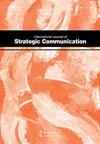一个短暂的蜜月。意大利媒体和政府关于新冠肺炎战略沟通的报道
IF 1.9
Q1 COMMUNICATION
International Journal of Strategic Communication
Pub Date : 2022-05-27
DOI:10.1080/1553118X.2022.2039664
引用次数: 4
摘要
COVID-19大流行等紧急情况是战略沟通的关键驱动力。各国政府必须实施宣传战略,确保公民的福祉,执行社会控制政策,以应对卫生紧急情况。本分析选择意大利作为案例研究,重点关注政府在2020年两次不同大流行期间对此类政策的战略传播的新闻报道,评估媒体是支持还是阻碍了这一传播。使用定量和定性分析相结合,我们确定了哪些新闻价值标准影响了新闻媒体的报道。换句话说,我们的重点不是战略沟通本身,而是议程设置。通过了解报纸讨论的新冠肺炎相关议题,我们可以评估“新闻价值观”是否以及如何影响媒体对政府战略沟通的报道,以及这如何影响国民的看法。我们的研究结果提供了一幅对比鲜明的画面:在第一波浪潮中,机构和媒体之间出现了一种“蜜月期”。相反,在第二次浪潮中,意大利媒体系统的新闻惯例——党派偏见和冲突叙事——影响了对大流行的叙述,破坏了Covid-19社会控制政策战略沟通的有效性。本文章由计算机程序翻译,如有差异,请以英文原文为准。
A Short Honeymoon. The Italian Press and the Coverage of the Government’s Strategic Communication on COVID-19
ABSTRACT Emergency situations like the COVID-19 pandemic are key drivers of strategic communication. Governments must implement communication strategies for ensuring the well-being of citizens, to enforce social control policies responding to a health emergency. Choosing Italy as case study, this analysis focuses on the press coverage of the government’s strategic communication of such policies, during two different pandemic waves in 2020, evaluating if the press supported or hindered it. Using a combination of quantitative and qualitative analysis, we identified which criteria of newsworthiness have influenced news media coverage. In other words, our focus will not be strategic communication per se, but on agenda setting. By understanding the COVID-19-related agenda of newspaper discussions, we will be able to assess whether and how “news values” have influenced the media coverage of the government’s strategic communication, and how this has influenced the perception of citizens. Our results offer a contrasting picture: during the first wave, a sort of “honeymoon” between the institutions and the press emerges. During the second wave instead, the journalistic routines of the Italian media system- partisanship and conflictual narrations- influenced the narration of the pandemic, undermining the effectiveness of the strategic communication of Covid-19 social control policies.
求助全文
通过发布文献求助,成功后即可免费获取论文全文。
去求助
来源期刊

International Journal of Strategic Communication
Social Sciences-Sociology and Political Science
CiteScore
3.40
自引率
0.00%
发文量
39
期刊介绍:
The International Journal of Strategic Communication examines the philosophical, theoretical, and applied nature of strategic communication, which is “the purposeful use of communication by an organization to fulfill its mission.” IJSC provides a foundation for the study of strategic communication from diverse disciplines, including corporate and managerial communication, organizational communication, public relations, marketing communication, advertising, political and health communication, social marketing, international relations, public diplomacy, and other specialized communication areas. The IJSC is the singular forum for multidisciplinary inquiry of this nature.
 求助内容:
求助内容: 应助结果提醒方式:
应助结果提醒方式:


